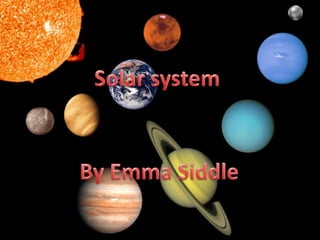Solar system
•Transferir como PPTX, PDF•
0 gostou•225 visualizações
Denunciar
Compartilhar
Denunciar
Compartilhar

Recomendados
Recomendados
Mais conteúdo relacionado
Mais procurados
Mais procurados (20)
Último
Último (20)
Optimizing NoSQL Performance Through Observability

Optimizing NoSQL Performance Through Observability
How Red Hat Uses FDO in Device Lifecycle _ Costin and Vitaliy at Red Hat.pdf

How Red Hat Uses FDO in Device Lifecycle _ Costin and Vitaliy at Red Hat.pdf
Future Visions: Predictions to Guide and Time Tech Innovation, Peter Udo Diehl

Future Visions: Predictions to Guide and Time Tech Innovation, Peter Udo Diehl
Powerful Start- the Key to Project Success, Barbara Laskowska

Powerful Start- the Key to Project Success, Barbara Laskowska
AI presentation and introduction - Retrieval Augmented Generation RAG 101

AI presentation and introduction - Retrieval Augmented Generation RAG 101
Introduction to FDO and How It works Applications _ Richard at FIDO Alliance.pdf

Introduction to FDO and How It works Applications _ Richard at FIDO Alliance.pdf
A Business-Centric Approach to Design System Strategy

A Business-Centric Approach to Design System Strategy
Simplified FDO Manufacturing Flow with TPMs _ Liam at Infineon.pdf

Simplified FDO Manufacturing Flow with TPMs _ Liam at Infineon.pdf
Integrating Telephony Systems with Salesforce: Insights and Considerations, B...

Integrating Telephony Systems with Salesforce: Insights and Considerations, B...
The Value of Certifying Products for FDO _ Paul at FIDO Alliance.pdf

The Value of Certifying Products for FDO _ Paul at FIDO Alliance.pdf
Salesforce Adoption – Metrics, Methods, and Motivation, Antone Kom

Salesforce Adoption – Metrics, Methods, and Motivation, Antone Kom
Linux Foundation Edge _ Overview of FDO Software Components _ Randy at Intel.pdf

Linux Foundation Edge _ Overview of FDO Software Components _ Randy at Intel.pdf
Extensible Python: Robustness through Addition - PyCon 2024

Extensible Python: Robustness through Addition - PyCon 2024
Solar system
- 2. The solar system planets…
- 3. The distances the planets have from the sun… • Earth- 149,600,00km • Mercury- 58,000,000km • Venus- 108,200,000km • Mars- 277,940,000km • Jupiter- 778,300,000km • Saturn- 1,427,000,000km • Uranus- 2,869,600,000km • Neptune- 4,498,000,000km
- 4. Earth is the only planet with human life on it Jupiter is the biggest planet known to man Uranus has never been visited before by any human on Earth Venus has a lot of flowing rivers Mercury is the closest planet to the middle of the solar system Neptune was discovered on 23rd September 1846 Mars has many dark long lines on it but no one can explain why Saturn has 5 rings around it
- 6. • Earth… • Neptune… • Earth has a temperature • Neptune has a blue that can be as low as appearance because of -89 degrees and as high a gas. as 58 degrees. • There is a lot of wind in • More than half of Earth Neptune and it travel is covered by water. really fast. • Earth is the only planet • Triton is one of the which grows plants and moons of Neptune and has creatures/animals it is the coldest place in living on it. our solar system because it can have a freezing temperature of -235 degrees.
- 7. • Mars… • Jupiter… • Mars is red because of • Jupiter is like a vacuum the dust on the planets cleaner of the solar surface. system. It sucks • Scientists think that Mars everything that could be used to be covered in harmful to Earth. long rivers but they are • A day on Jupiter is less not there anymore. They than 10 hours long. think water can still be • Jupiter weighs more in found in the planets soil. mass than Earth does. • There’s a big volcano on • If we could stand on Mars called Olympus Jupiter we would weigh 3 Mons. It’s four times times our normal weight bigger than mount because Jupiter has a very Everest! strong pull of gravity.
- 8. • Mercury… • Venus… • No one has ever found • After the sun and a moon of Mercury yet. moon, Venus is the • Mercury can be as cold brightest object from as -170 degrees but it Earth. can be as warm as 350 • There is no more degrees. volcanoes on Venus. • A year on Mercury is • Venus is the second only 88 days long but a planet closest to the full day takes 176 days. sun. • Mercury is a bit bigger • Venus is named after than Earth’s moon. the goddess of love.
- 9. • Saturn… • Uranus… • Saturn is the second • Uranus has at least 27 biggest planet. It’s so moons on it. big Earth could fit into it • Uranus was the first 755 times! planet to be discovered • Saturn does have very (in 1781). stormy weather. • Uranus is a very dull • A year on Saturn would blue colour and is take almost thirty Earth mainly made up of gas. years even though a day • Saturn is a very unusual on Saturn would be 10 planet because it orbits ½ hours. years. the sun on its side. However, a day on Saturn is about 10 and a half hours.
- 10. I hope you enjoyed my presentation and learnt loads of interesting facts about the solar system and it’s planets!